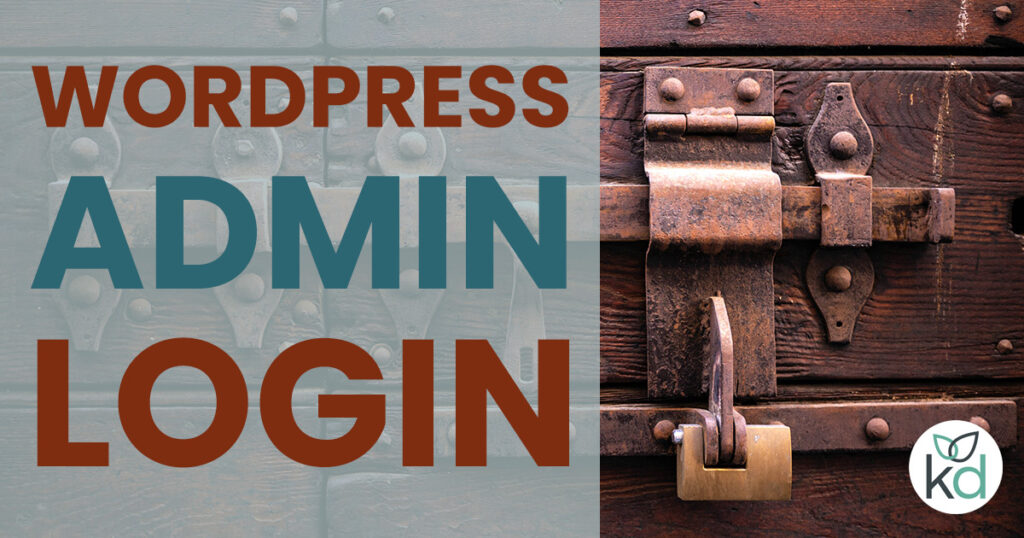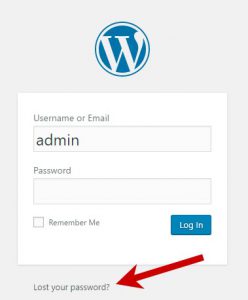In this guide, I outline the requirements for WordPress.com admin login – the default username, the default WordPress login URL and how to find it, plus the lost password link.
More advanced instructions are detailed at the end of the post – on the WordPress install folder, how to find that via FTP and adding an administrator via the database.
Requirements for WordPress.com login
- The WordPress.com admin login URL
(aka web address, link or WordPress login page). - Your WordPress username.
- WordPress password.

Simple WordPress login
Got the essentials listed above? Then let’s get you logged in to the admin area of WordPress.
The default WordPress URL is websiteaddress.com/admin. Try this login URL first, as it is often the best bet.
- Navigate to the WordPress URL to view the login form.
- Type in the WordPress username and password into the form fields and hit Log In.
The default username is admin. (Later, I recommend you change this for security reasons). - Once logged in, you’ll arrive at the WordPress Dashboard.
However, logging in to the WordPress admin area is not always this easy. Like most things in life.
The login URL and the username might’ve been changed, so that simple set of instructions might not work.
Changing the URL and the username is good practice and will keep the website more secure, so kudos to the person who set it up. Now there are two more options.
If you came to the WordPress admin login screen, but the username and password didn’t work, read on for further help.
Anyone who came to a 404 error when bringing up the admin screen should skip to the next section – Default WordPress login URL.
WordPress username and password
The default WordPress username is ‘admin‘, although an experienced web developer will create one that’s much harder to guess. Changing the username helps prevent a website from being hacked.
The password is chosen during the WordPress install or by the person that added you as a user.
Lost WordPress password
If you have lost the username or password (or both), navigate to the WordPress login URL, then click the “Lost your password” link as per the image below.

You must have an idea of the username or associated email address for this to work.
- On the next screen, enter either the imagined username or email address.
- Once entered, click “Get new password”.
If this step works, an email will be sent to the email address associated with the account.
WordPress will never send the existing password for security reasons – it can only be changed. To change it, you need access to the registered email address.
Go to the email and click the link to reset the password. Check your SPAM box for that ‘reset email’ – WordPress emails often end up in SPAM or DELETED mail.
If you don’t receive the reset email even after checking ALL email accounts (personal ones, too), read on.
No access to WordPress user email
If you no longer have access to the email address associated with your WordPress account, you won’t be able to reset the password.
It is entirely possible to change a password if you have access to the database, usually accessed via the hosting control panel.
An administrator can be added by accessing the database directly.
At this stage, if you’re not technical, I advise you to request help from a web developer with MySQL experience.
Technical people – scroll to the bottom of this post.
Default WordPress login URL
URL is an acronym for Universal Resource Locator, which (more or less) means website address.
The default WordPress login URL is appended with /login or /admin, e.g.:
websiteaddress.com/login or websiteaddress.com/admin
However, the standard login URL could have been changed by the website creator. I will explain it.
WordPress websites can be developed within a directory on the server; therefore the URL could be something like:
websiteaddress.com/folder/login.
For security reasons, a web developer could have changed the default WordPress admin URL, making it something more obscure.
If the default WordPress URL does not bring you to the WordPress login screen, contacting your web designer is the easiest way to find the correct URL.
Keep reading if that isn’t an option.
Find your WordPress login
If you’ve lost touch with the website developer or are the website developer, the next option is to use an FTP client to view the files on the server.
FTP stands for File Transfer Protocol. An FTP client is a programme that allows us to move files from a computer to a server.
There is often a ‘file manager’ available within the control panel of the ISP (the hosting provider); this will do the job.
Use your FTP programme to discover if the WordPress install is contained within a folder.
Knowing the folder structure helps figure out the WordPress admin login page.
When the install is within a folder, the default WordPress login URL may look like this:
websiteaddress.com/folder/login
WordPress security plugins and a hidden WordPress login URL
There could be a WordPress security plugin changing the default WordPress URL. When trying to access the default WordPress login screen, users face a 404 error message.
If you suspect you have a WordPress security plugin installed, you will need to use an FTP client to log in to the server.
Navigate to the plugins folder within the WordPress install.
We will temporarily disable the plugin to at least log in to the site.
- Rename the folder of the security plugin to disable it –
e.g. “better-wp-security” could become “disable_better-wp-security”.
Renaming the folder will disable the plugin and all security features until you revert to the original folder name.
Now use the default WordPress URL to access the site and make necessary changes.
Please make sure you change the folder to the correct name to secure the website.
TIP: Revert the folder name to the original whilst still logged in to the WordPress admin area. WordPress usually kicks you out once the security plugin is reactivated, but if not, go to the security settings and find the hidden URL. Note this down for next time you want to log in.
Add an administrator via the WordPress database
Download a copy of the database before taking any of the steps below.
Using the control panel details for the ISP, you should access the WordPress database using PHPMyAdmin.
Check you are editing the correct database by checking the wp-config file. Download it with an FTP programme. Check the line:
define(‘DB_NAME’, ‘hereisthename’);
<hereisthename> being the name of your database.
Once in the correct WordPress database, add an administrator associated with a current (working) email address.
A brilliant tutorial on WP Beginner explains how to add an administrator using MYSQL.
If you do not have experience, please be careful.
Contact me or comment below if you would like help adding an administrator.
Keep your WordPress password safe
Keep your password safe for next time using software such as KeePass.
Logging in to WordPress is simple if you have the correct details to start with; however, it can become a nightmare if you lose touch.
For help gaining access to a site, get in touch with me, a WordPress website designer or comment below.
When logging in to WordPress admin, try the following:
- Go to websiteaddress.com/admin.
- If you see a log-in screen, you can try hitting the LOST PASSWORD button.
- A 404 error means the WordPress install is within a folder, or a security plugin has been activated.
- Find a control panel password or FTP password to view the files on the server.
- First, check if the WordPress install is within a folder, then try logging in using websiteaddress.com/folder/admin
- It likely has a security plugin installed if it’s not in a folder.
- Use the FTP programme to go to the <wp-content> folder, then into <plugins>. Rename the folder. Now try logging in to WordPress.
- Once you have logged in, remember to activate the security software again.
Let me know in the comments if you get stuck logging into the WordPress admin area.

hello can you help me ant login to my website been nearly a year just keeps saying error 404
Hi Caroline, yes I can help you to log in to your WordPress website. Would you email me on [email protected], as we can start from the beginning, and try to get you logged in the simple way first.